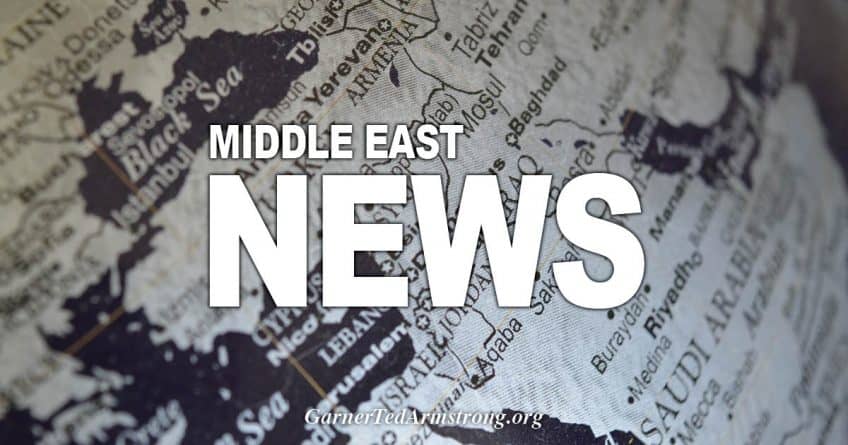An examination of the more distant and recent past are necessary to understand the series of explosions that have rocked Iran in recent days.

An Iranian flag flutters at Iran’s Bushehr nuclear power plant, November 2019.Credit: ATTA KENARE / AFP
Understanding the series of explosions and fires that have rocked Iran over the past week, particularly the explosion at the uranium enrichment plant at Natanz, requires us to travel back in time 18 years.
In August 2002, the National Council of Resistance of Iran, an umbrella group of exiles and opponents of the Islamic regime, revealed that Iran was building an underground uranium enrichment facility near Natanz. At the same time, it was revealed that the government had set up a workshop in one of Tehran’s industrial zones that was masquerading as an electronic watch factory run by the Kalaye Electric Company, but was actually constructing centrifuges.
Unlike Israel, Iran is a signatory to the nuclear Non-Proliferation Treaty, and as a member state is obligated to report to the International Atomic Energy Agency on any facility, equipment or nuclear material on its territory, even if it is for peaceful means. The Iranians’ usual practice has been to deny the existence of banned facilities, only admitting to their existence when forced to. And even when acknowledging them, the Islamic republic made every effort to buy time, until finally being forced to let international nuclear inspectors into the Tehran workshop, the Natanz facility and other sites linked to its nuclear program.
Since then, IAEA inspectors have paid visits to the facilities at varying intervals.
According to foreign reports, Israeli intelligence – the Mossad and the Israeli army’s Unit 8200, with the help of other espionage agencies – exposed the illegal activity at Natanz and “laundered” the information via Iranian opposition groups. It later became clear to the CIA and Britain’s MI6, from information supplied by the late Libyan dictator Muammar Gadhafi, that Iranian nuclear scientists had built centrifuges to enrich uranium based on knowledge and technology secretly acquired from Abdul Qadeer Khan, the father of Pakistan’s nuclear bomb.
The discovery of the Natanz facility was a wake-up call for intelligence communities in Israel, the United States, and elsewhere, indicating Iran’s determination to pursue its nuclear program through every possible channel – uranium enrichment, laser enrichment, and plutonium production. According to foreign reports, against this backdrop, operational-intelligence cooperation grew between Israel and the United States during President George W. Bush’s time in office.
Among other efforts, they would carry out various programs to step up intelligence gathering (via agents, wiretapping and computer hacking), and through increased infiltration of Iran’s procurement networks around the world – in an effort to have the Iranians provided with faulty information and technology – to sabotaging equipment on its way to Iran and damaging the nuclear facilities themselves.
- The Explosion at Natanz Is a Direct Hit on Iran’s Nuclear Program
- For Now, Iran Faces Bigger Threats Than Mysterious Explosions at Nuclear Sites
- Fire at Iranian Nuclear Facility Could Slow Down Centrifuge Development, Official Says
Journalist James Risen wrote about one of these programs in his 2006 book “State of War: The Secret History of the CIA and the Bush Administration.” According to the book, the Mossad and the CIA plotted to sabotage the electric grid near Iran’s nuclear sites through the use of electromagnetic pulses. Experts working for the CIA went to a testing site in Nevada to try out their technology on a model they had set up there. The book stated that the Mossad volunteered to smuggle the necessary equipment into Iran via agents in the country.

A view of a damaged building after a fire broke out at Iran’s Natanz Nuclear Facility, in Isfahan, Iran, July 2, 2020.Credit: /AP
But when it tested out the technology and assessed its viability, the CIA decided to scrap the program on the grounds that it was not feasible and was too dangerous. Carrying out the plan would have required smuggling trucks into Iran and loading them with heavy equipment. Subsequently, according to reports, Mossad directors (Meir Dagan and Tamir Pardo), Israeli army intelligence chiefs (Aharon Ze’evi-Farkash, Amos Yadlin, and Aviv Kochavi), along with commanders of Unit 8200, got together with the Americans and other espionage agencies to find other creative ways to damage, disrupt and delay Iran’s plans.
It was clear to those involved in the work that it was necessary to assemble a wide-ranging set of tools that would make systematic, coordinated, international operations possible and force Iran to suspend its nuclear program at the very least. No one ever imagined that Iran would give up its plans for the nuclear option, if not the construction of an actual atomic bomb.
According to foreign reports, this toolbox included inserting a computer virus into electricity boxes manufactured by the German company Siemens, which were connected to the computers running the Natanz centrifuges. The virus was dubbed Stuxnet and the joint operation by the Mossad, the CIA, Unit 8200, and its U.S. counterpart at the National Security Agency, was called Operation Olympic Games (as revealed in the United States in 2011).
More advanced centrifuges
In 2009, it was discovered that the Iranians had built another uranium enrichment site at Fordo, near the city of Qom, which was built even deeper in the ground than the Natanz facility and would be difficult to destroy. (The Israel Air Force does not have bunker-busting bombs as the United States does).
It also turned out that Iranian experts had managed to develop centrifuges that were more advanced than those acquired from Pakistan. The Iranian ones were capable of enriching larger quantities of uranium in less time.
As the other operations were proceeding, nuclear scientists who were part of Iran’s nuclear “weaponization” team, responsible for the most critical stage of nuclear weapons production, began to disappear one after another. The U.S. secretary of state at the time, Hillary Clinton, declared that her country was not involved in the deaths or assassinations. From her statement and prior precedents and analyses, the international media attributed the assassinations to the Mossad.
According to foreign reports, these operations were a mix of Mossad, Iranian agents, and others assigned to the task. It was clear that the assassinated scientists would be replaced by others, but the targeted killings also had a psychological aspect – consisting of a threat that it was hoped would dissuade Iranian scientists working at universities from joining the secret military project.

This July 3, 2020, satellite image from Planet Labs Inc. shows a damaged building after a fire and explosion at Iran’s Natanz nuclear site.Credit: /AP
In addition to the killings and sabotage, the United States and other Western powers (and later, following a UN Security Council resolution, Russia and China) increased diplomatic and economic pressure on Iran. Here, too, the Mossad played an important role, being involved in gathering information that would be the basis for targeting Iranian companies and the financial sectors upon which sanctions could be imposed.
Iran’s economy was hit hard and in 2013 the Iranians agreed to enter negotiations, which in July 2015 produced the international nuclear agreement with the six major powers, which was signed in Vienna (the JCPOA).
Most senior Israeli defense and intelligence officials expressed the view that, despite its shortcomings, the deal was the least bad of all available options. But Prime Minster Benjamin Netanyahu thought otherwise and began to do all he could to scuttle the agreement. Threats made by Netanyahu and then-Defense Minister Ehud Barak, backed by visible air force exercises, created the impression that a military strike was imminent and unavoidable. It was one of the most successful deception operations in history.
Netanyahu also appeared before members of Congress in March 2015 to speak out against the agreement, a deal then-President Barack Obama supported. It’s possible that without Netanyahu’s involvement, a better agreement could have been achieved.
Main task
In 2016, Yossi Cohen was appointed as director of the Mossad. As he has told associates, his main task was to obtain information proving that Iran was violating the nuclear deal. One of his major accomplishments was the break-in at Iran’s nuclear archive in January 2018 and the theft of its contents, which were brought back to Israel. (On Sunday, Netanyahu extended Cohen’s term as director by another six months, until June 2021.) But even this impressive intelligence coup didn’t yield diplomatic results. The world seemingly wasn’t impressed by the findings and stuck to its position that the nuclear agreement should be respected.
On the other hand, President Donald Trump, with backing and persuasion from Netanyahu, announced in 2018 that the United States would be unilaterally withdrawing from the agreement. Following that, Iran began violating the deal – including, most significantly, with its renewed efforts to develop advanced centrifuges.
This is the backdrop for recent events in Iran: four explosions and fires, which occurred at an X-ray lab in Tehran; a missile base at Parchin (where the weaponization program was based); a power plant in Ahvaz, an area that is home to Iran’s Arab minority; and the enrichment plant at Natanz.
Speaking Sunday, Defense Minister Benny Gantz and Foreign Minister Gabi Ashkenazi reiterated Israel’s traditional responses on the subject. Ashkenazi said Israel would not permit Iran to develop nuclear weapons, while Gantz explained that not every unusual “event” is linked to Israel. The defense minister noted that Iran has had a history of major accidents due to faulty maintenance and outdated equipment, as a result of the sanctions against the country.
Gantz and Ashkenazi both know what the late head of the Mossad, Meir Dagan, used to frequently say: that Iran is a mosaic of ethnic groups (including Arabs, Kurds, Baluchis, and Azeris) who are not pleased with the regime and have formed underground groups. According to foreign reports, some of these groups are gaining assistance from the CIA and the Mossad.
It’s possible that a combination of the comments by the two Israeli ministers along with Dagan’s view might provide an explanation as to what is currently happening in Iran. Israel is doing absolutely everything it can to prevent Iran from moving ahead with its nuclear program, while Iran is prone to accidents and is exposed to terrorist attacks.
Whether or not Israel is responsible for these events, the fact the Iranians are accusing Israel only enhances the prestige of Israeli intelligence, while simultaneously damaging Iran’s own morale and its self-image. The major question is, if Iran retaliates, whom would it retaliate against, and how? A cyberattack on Israeli installations, as occurred earlier this year, is just one option.
[Disclaimer]








